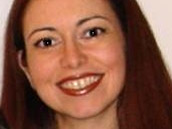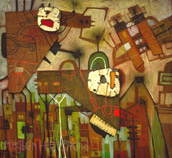The Second Coming of Hemingway
Claudia Del Balso
Last
year I learned that one of Hemingway’s nicknames was Papa.
I learned this the same day I first met Archibald MacLeish. It was a
beautiful December morning and it was unseasonably cool for Key West.
Archibald was sleeping on Papa’s bed. His body lay in a
C shape and his right arm partially covered his face as if trying to
make himself invisible from the crowd around him.
“And this is Archibald, one of Snowball’s many
descendants,” said Mike, our tour guide.
Archibald,
the orange-striped cat had been born with four white booties and a
white furry bib that grew out of his chin downward. His ears started
to twitch as the tour guide spoke.
My husband is a cat lover. He took several pictures of the sleeping
feline, while Mike continued telling us the story of Snowball.
“Snowball was our first polydactyl cat here.” Mike added,
“He was given to Hemingway as a gift from a ship’s
captain who believed he would bring him bad luck aboard…”
‘What’s that?’ The girl next to me asked her
father.
“That means the cat has an extra toe,” the father
answered.
Archibald
was not a six-toed cat like his predecessor. His paws were not
mitt-like. They didn’t look like a paper fan or a boxer’s
glove.
The herd of tourists following Mike exited Hemingway’s bedroom
and disappeared in the narrow hallway on the second floor. My husband
and I stayed behind: I wanted to inspect the multi-coloured cat
sculpture, encased in a glass box on top of an armoire. My husband
wanted to videotape Archie.
Then, standoffish Archie slowly opened his eyes and raised his head.
His pupils dilated and his tail thrashed. He was probably annoyed to
find us still there, interrupting his nap.
As we continued our tour, we saw several black-and-white photographs
on the walls, displaying Hemingway’s four wives and some of his
lovers. A lot of the photos included his cats: Ernest at his studio
and a cat on his desk, Ernest in the garden and two cats next to him,
another one of Ernest feeding one of the cats.
I commented on Hemingway’s peculiar love for cats. This
prompted my husband’s smartass remark.
“I think he had as many lovers as he had cats,” he
smirked.
Among these photos, one stood out like the extra thumb on Snowball’s
paw: Hemingway with two of his children playing with three cats at his Cuba home.
“I like this picture,” I said as I stood in front of it.
My husband took off his glasses, tilted his head, and inspected it
closely. “Hmm, these cats are not polydactyls,” he said.
As I
learned more about Hemingway, I was beginning to think that
everything in his life was a plus-one like the extra toes on his
cats.
My husband and I ran into several of Snowball’s descendants in
the hallway, the living room downstairs, and the garden, lounging
and wandering the grounds at their leisure. I noticed that not
all of them were polydactyl: the ones with the extra toes walked as
if they wore invisible snowshoes. Watching these cats made me wonder
if it skips a generation or two. Could it be the recessive gene comes
from Snowball’s mate?
We caught up with Mike and the group. Just in time as he was
introducing Charley Chaplin, a furry black-and-white
cat that grew a black goatee around his white mouth. Unlike
Archie, Charley wasn’t aloof. He let everyone pet him. He loved
the attention and he seemed to pose for the myriad of pictures
tourists took of him. Yes, a clever name indeed for a tomcat that
seemed to embrace the limelight.
“All of our cats have names of famous people,” Mike
explained. “We’ve had from Gertrude Stein, to Emily Dickinson, who’s a polydactyl, to
Audrey Hepburn...even Sofia Loren.”
A woman from the group interrupted, “How come they all have
female names?”
Mike laughed and said, “Oh, no! We’ve also had our share
of male celebrities, including
Pablo Picasso and Hairy Truman, who’s also a
polydactyl.”
People laughed.
How brilliant! I thought. It seems that Hemingway’s
circle of friends, acquaintances, and role models has continued to
live through the cats. I did notice that none of the female cats were
named after his wives. Why didn’t I ask Mike about it?
Mike also pointed out that there was a small cat cemetery on the
grounds.
A morbid interest in death suddenly appealed to me. I had never been
in a pet cemetery. I’d only seen one in the movie Pet
Cemetery: the grim, eerie, foggy place that gives you the creeps.
“I want to see who’s buried there,” I said, almost
enthusiastically.
So, my husband and I took a small detour to the cemetery. We followed
the red-bricked path. It was in a corner of the backyard, behind some
plants, not far from the stairs that led to Ernest’s studio and
the back of the house. I was surprised to discover this was not the
typical pet cemetery depicted in the movies. It was surrounded by a
lot of plants and red bricks which made it very colourful. It was
also very small; maybe the size of an 18’ x 21’ area rug.
I doubted all the cats that once inhabited the house fitted in that
small plot of land. A few tombstones with the names of the deceased
were erected against the wall that fences in Ernest’s house.
The rest of the names with their respective dates were engraved on
cement slabs.
We rejoined our tour group in the pool area where we found…
what else? More cats! I stopped counting after a while, but I took
Mike’s word for it when he told us at the beginning of the tour
that there were about sixty cats on the premises. We kept running
into Charley Chaplin. We had first met him in the courtyard in front
of Ernest studio. We then saw him in the back garden that leads to
the cemetery. And now Charley was standing by the pool where Mike
started telling us about Ernest’s rocky relationship with
Pauline, his second wife. She had built the
pool in his absence, without his permission (the Florida Keys’
first swimming pool). This cost him a fortune, literally.
I petted Charley. His fur was silky. He arched his back and pointed
his bushy tail like an antenna. Charley seemed satisfied after a few
strokes and wandered among the slew of legs standing still like
Floridian palm trees.
As we faced the pool, I saw a cat sitting in the pebbled path. Then
another one tucked in under the bushes that surrounded the pool.
“Have you seen Archibald?” I asked my husband.
“He probably is still sleeping.”
I didn’t blame Archie. That bed looked comfortable.
“That cat had an attitude,” I said.
“Don’t they all?” my husband smirked.
But why wouldn’t he? After all, he was Snowball’s
descendant. He was entitled to sleep on Papa’s bed. If
Hemingway were alive, he’d probably sleep with him.
As we neared the end of our tour, we gathered around by a large
antique Spanish olive jar that had been brought by Pauline. It sat on
the garden on the left-hand corner of the back of the house. Lush
emerald vegetation surrounded the1851 colonial,
southern-style house. I was smitten by
the two-story home as I admired it from this angle. I breathed
deeply and Mike’s voice floated away with the brisk December
air. I felt the spirit of Hemingway was very much alive in the
mansion. I pictured Hemingway opening its
French doors to let the tropical breeze in, walking on the veranda
with views of the Key West Lighthouse, drinking a glass of cognac. I
imagined him walking through his paradisiacal garden followed by his
cats. I also deduced that Hemingway had the spirit of a cat:
independent, whimsical, wanderer. Nothing wrong with that!
“And to end our tour, I thought I left the best for last,”
said Mike, pulling me back out of my reverie to 2009. “This
water fountain here has a funny story attached.” He added.
There was a urinal lying horizontally next to
the big Spanish jar. Of course, it was hard to tell what it really
was unless one knew the story behind it. Mike then told us how this
fixture ended up here. This had been Hemingway’s retaliation
for his wife’s whim on building the pool that led him to
bankruptcy. Ernest brought the urinal from Sloppy
Joe’s, his friend’s
restaurant that was being relocated.
When Mike repeated what Hemingway said to his
wife, “If you get rid of your pool, I’ll get rid of
mine,” some of us in the group laughed (I say some
because only married couples would probably appreciate the joke
behind it). Now, this is a side of Hemingway I hadn’t imagined.
A prankster!
When Hemingway refused to remove the urinal, Pauline budged. She had
it decorated with Spanish tiles to make it less offensive, and added
the Spanish olive jar next to it. This is now the cats’
fountain.
“Would you believe that Archie, the orange cat on Ernest bed,
remember him?” Mike asked. “…is the ONLY cat that
doesn’t drink out of the urinal.”
Everybody laughed. I couldn’t believe my ears.
“Archie ONLY drinks from the water streaming down the jar,”
Mike said, almost proudly. His tone sounded as if he knew a secret,
one that he’d only share with Archie.
“Amazing, isn’t it?” I whispered.
My husband nodded.
I nudged him. “That’s it!”
He
looked at me as if I had had a few glasses with Ernest. Yes! Mike had
told us earlier how much Ernest loved drinking, perhaps as much as
writing.
“Archie is Ernest!” I declared.
As everyone was applauding, pleased with Mike’s
last words, my husband didn’t hear me. People started gathering
around Mike to tip him. My husband included. I just stood there
baffled at my new discovery. Ernest loved Key West, his house, and
his cats very much. Perhaps he had never left after all. After the
tour, my husband and I went inside the gift shop. It was there
I learned the sculpture that had caught my attention in Papa’s
bedroom had been a gift from Picasso. Sadly, the original was broken
by a thief. So, I brought home a piece of that cat in the shape of a
mug.



